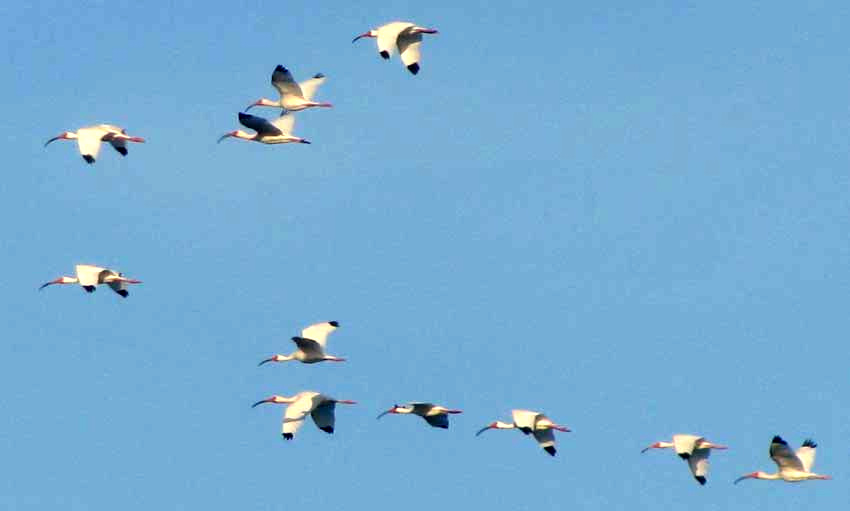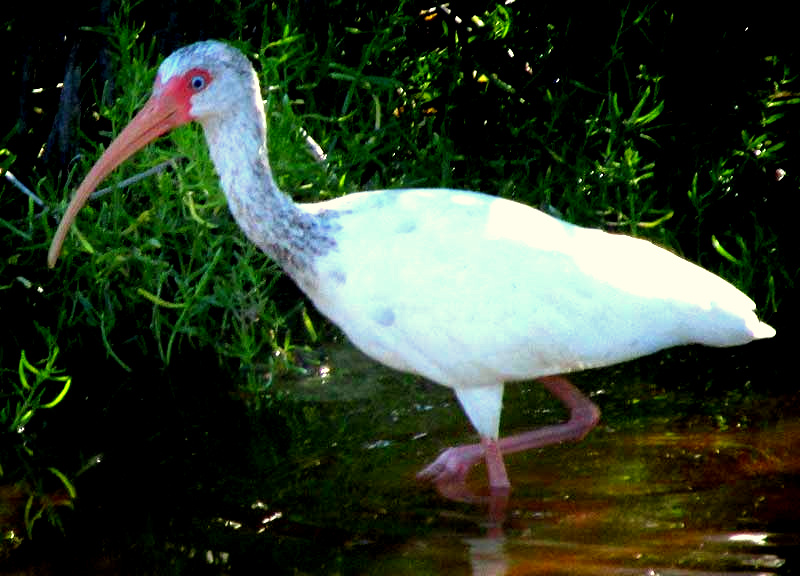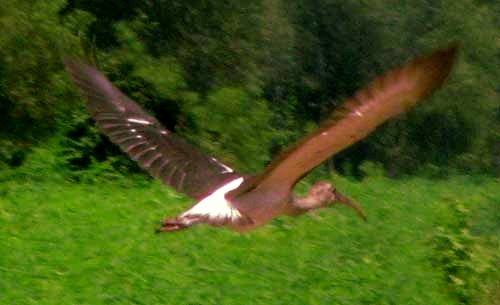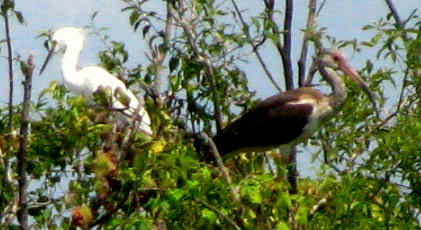Excerpts from Jim Conrad's
Naturalist Newsletter

from the June 6, 2011 Newsletter issued from written at Mayan Beach Garden Inn 20 kms north of Mahahual, Quintana Roo, México
IBISES AWING
This week I've also seen a couple of flocks of White Ibises wing past our part of the beach, both flocks heading northward. You can see a flock of eleven above.
With their long, downcurved beaks and white wingtips they were easy to identify. Saying why they were so deliberately looking flying northward is harder to know, since White Ibises are permanent residents here, found year round in mangroves, brackish lagoons and even sometimes freshwater marshes. Ever since I've arrived here I've seen occasional flocks over the mangroves. Maybe the ones in the pictures were just some local folks with a hankering for fresh ocean breezes.
from the October 26, 2014 Newsletter issued from Río Lagartos, on the north-central coast of Yucatán, MÉXICO
WHITE IBIS WITH A BROWNISH HEAD
One service I can provide to birders visiting the Yucatan during the northern winter is to illustrate birds in their transition and winter plumages, which often aren't well covered in field guides. Below, you can see a White Ibis in the mangroves at the edge of town, a bird transitioning into its adult plumage, with a white body and brownish head and neck:

Two ibis species occur here, the other being the Glossy Ibis, all stages of which are dark, the adult being bronzy brown, and always with a blackish beak.
from the June 27, 2004 Newsletter issued from just east of Natchez, Mississippi, USA
JUVENILE WHITE IBISES
We've seen lots of White Ibises in Mexico, but they didn't look like the ones spotted this weekend in St. Catherine Creek National Wildlife Refuge's pump-flooded fields. Our Mexican White Ibises have been white. You can see the brown wings and brownish head but white rump of a juvenile White Ibis flushed from a flooded ditch below:

Another brown-winged juvenile foraging on a flooded field's spillway took to the air when we drew too near and landed nearby. You can see him next to a similarly spooked Snowy Egret below:

White Ibises breed in our area and might overwinter during mild winters.
from the June 27, 2004 Newsletter issued from just south of Natchez, Mississippi, USA
WHITE IBISES
I emerged from the woods near the Field Pond, hoping that maybe the long-necked birds that had flown by in V-formation might have landed there. One of them had, and I got a good look at him as he flew away. Brown on top but with a white rump and a wingspread of about 38 inches (97 cm), long neck and legs, and a very long, down-turned beak, it was an immature White Ibis, EUDOCIMUS ALBUS. White Ibises are found from Peru to the coastal US Gulf and, during summer, a bit inland here, including the southern half of Mississippi.
The White Ibis's favorite food is crustaceans, with crayfish at the top of the list. At the pond, crayfish inhabit a muddy spot with tall grass, so this juvenile was smart to have landed there. The diet also includes insects, snails, frogs, worms, snakes, and small fish. White Ibises forage by walking slowly in shallow water, sweeping the bill from side to side and probing at the bottom.